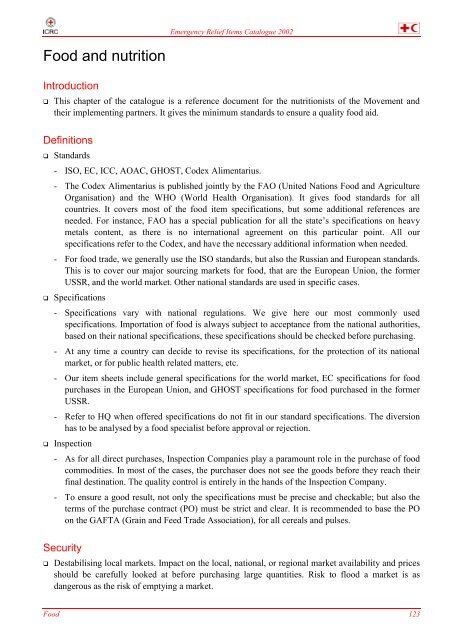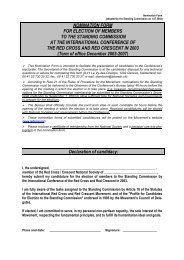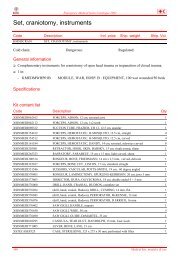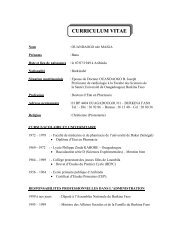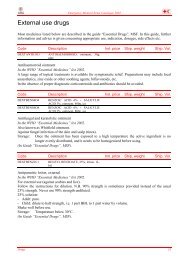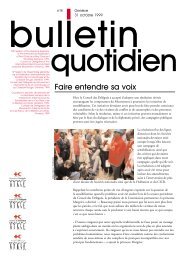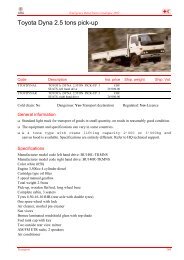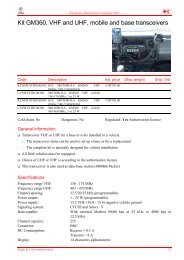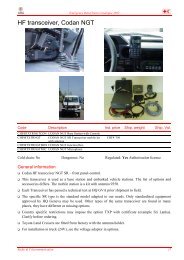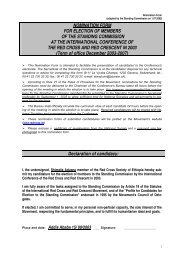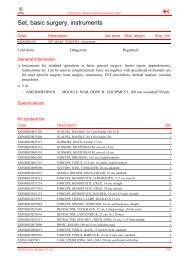Food and nutrition - International Red Cross and Red Crescent ...
Food and nutrition - International Red Cross and Red Crescent ...
Food and nutrition - International Red Cross and Red Crescent ...
You also want an ePaper? Increase the reach of your titles
YUMPU automatically turns print PDFs into web optimized ePapers that Google loves.
Emergency Relief Items Catalogue 2002<strong>Food</strong> <strong>and</strong> <strong>nutrition</strong>IntroductionThis chapter of the catalogue is a reference document for the <strong>nutrition</strong>ists of the Movement <strong>and</strong>their implementing partners. It gives the minimum st<strong>and</strong>ards to ensure a quality food aid.DefinitionsSt<strong>and</strong>ards- ISO, EC, ICC, AOAC, GHOST, Codex Alimentarius.- The Codex Alimentarius is published jointly by the FAO (United Nations <strong>Food</strong> <strong>and</strong> AgricultureOrganisation) <strong>and</strong> the WHO (World Health Organisation). It gives food st<strong>and</strong>ards for allcountries. It covers most of the food item specifications, but some additional references areneeded. For instance, FAO has a special publication for all the state’s specifications on heavymetals content, as there is no international agreement on this particular point. All ourspecifications refer to the Codex, <strong>and</strong> have the necessary additional information when needed.- For food trade, we generally use the ISO st<strong>and</strong>ards, but also the Russian <strong>and</strong> European st<strong>and</strong>ards.This is to cover our major sourcing markets for food, that are the European Union, the formerUSSR, <strong>and</strong> the world market. Other national st<strong>and</strong>ards are used in specific cases.Specifications- Specifications vary with national regulations. We give here our most commonly usedspecifications. Importation of food is always subject to acceptance from the national authorities,based on their national specifications, these specifications should be checked before purchasing.- At any time a country can decide to revise its specifications, for the protection of its nationalmarket, or for public health related matters, etc.- Our item sheets include general specifications for the world market, EC specifications for foodpurchases in the European Union, <strong>and</strong> GHOST specifications for food purchased in the formerUSSR.- Refer to HQ when offered specifications do not fit in our st<strong>and</strong>ard specifications. The diversionhas to be analysed by a food specialist before approval or rejection.Inspection- As for all direct purchases, Inspection Companies play a paramount role in the purchase of foodcommodities. In most of the cases, the purchaser does not see the goods before they reach theirfinal destination. The quality control is entirely in the h<strong>and</strong>s of the Inspection Company.- To ensure a good result, not only the specifications must be precise <strong>and</strong> checkable; but also theterms of the purchase contract (PO) must be strict <strong>and</strong> clear. It is recommended to base the POon the GAFTA (Grain <strong>and</strong> Feed Trade Association), for all cereals <strong>and</strong> pulses.SecurityDestabilising local markets. Impact on the local, national, or regional market availability <strong>and</strong> pricesshould be carefully looked at before purchasing large quantities. Risk to flood a market is asdangerous as the risk of emptying a market.<strong>Food</strong> 123
Emergency Medical Items Catalogue 2002Marking <strong>and</strong> origin. For safety reasons, markings related to the country of origin of the food mighthave to be avoided in some countries.The expression “fit for human consumption” may sound very vague, <strong>and</strong> not inspectable. In fact,behind this expression, there is a package of points to be controlled, mainly on heavy metals, onmicro-organisms <strong>and</strong> on pesticides presence in the food commodity. The laboratory will then referto the laws in force in the specific country <strong>and</strong> check all items accordingly.Product durability. We find 4 types of date on food items: The “Use-by date”, the “date ofminimum durability” the “date of manufacture” the “date of packaging”.- “Date of manufacture” means the date on which the food becomes the product as described.- “Date of packaging ” means the date on which the food is placed in the immediate container inwhich it will be ultimately sold.- “Date of minimum durability” (“best before”) means the date which signifies the end of theperiod under any stated storage conditions during which the product will remain fully marketable<strong>and</strong> will retain any specific qualities for which tacit or express claims have been made. However,beyond the date the food may still be perfectly satisfactory.- “Use-by date” (recommended last consumption date, expiration date) means the date whichsignifies the end of the estimated period under any stated storage conditions, after which theproduct probably will not have the quality attributes normally expected by the consumers. Afterthis date, the food should not be regarded as marketable. Under specific circumtances, one mayproceed with laboratory tests to extend the “Use by date”.The discussion about GMO (Genetically modified organisms) is still going on in the Movement.This catalogue does not bring any answer on this subject. The only thing we do here is to include inthe specification an obligation of information.Stocking foodAs food is an “alive commodity”, one should pay a particular attention to the storage conditions.We too often see infested food stocks, or food not consumed before the “ use-by date”.All type of grains <strong>and</strong> grain sub-products are sensitive to insects <strong>and</strong> rodents. Large stockpiles canalso present physical danger like overheating, blasting, or falling. It is important to bring in the rightcompetence to prevent all these damages. Specialised companies as well as state departments forfood <strong>and</strong> health are major partners in this matter. The most important being a very close control ofthe food stocks, with regular check up of the stock condition (once a week is a minimum). Movingstock piles <strong>and</strong> fumigation are the most common operations to be applied regularly (at least every 3month, more if needed).Humidity <strong>and</strong> heat are the most important factors to fight against when stocking food. There are thecauses of microbiological growth, of insect infestation, of piles over-heating. All warehouses mustbe well ventilated <strong>and</strong> dry.Budget pricingThe item sheets include an indicative price to serve as a first gross estimate for budgeting, thoseprices do not include transport costs.<strong>Food</strong> prices are permanently fluctuating from one country to another, from one month to another.124 <strong>Food</strong>


